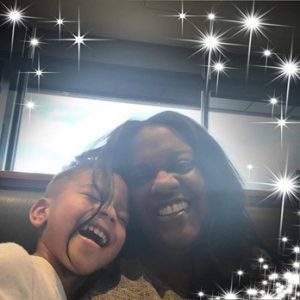Positive Affirmations in STEM
Posted on February 25, 2022 in Insights

It is essential to build a child’s self-worth to provide confidence in education. The aspirations and interests of children, in particular black and brown boys, are grounded in their community and culture. The first seed of confidence begins at home. Parents are widely considered a crucial part of their children’s educational attainment and are arguably the closest to and most knowledgeable about their children’s educational experiences. Research shows that parents’ involvement in schools, their parenting practices, and socialization at home have both direct and indirect implications for children’s academic outcomes (Banerjee, Harrell, & Johnson, 2011; Jeynes, 2007; Smalls, 2009).
 A firm believer in each one, teach one, providing Winston with positive aspirations through STEM has indeed grounded him in becoming a person full of imagination and charm. The book “I am smart, I am blessed, I can do anything!” by Alissa Holder & Zulekha Holder-Young provides aspirations for young black and brown boys to see themselves as capable human beings. Identity as an understanding of the self sits within a psychological orientation that, according to Erikson (1950, 1968), develops an integrated and functional sense of identity, which helps to unify the various aspects of an individual’s life and to provide a sense of personal meaning and direction. According to Heidelberg (2013) stated, “this view of identity is important for individuals to provide a sense of personal self and direction and is the focus of those who are interested in the way in which individuals develop self-knowledge, self-construction, and self-discovery.”
A firm believer in each one, teach one, providing Winston with positive aspirations through STEM has indeed grounded him in becoming a person full of imagination and charm. The book “I am smart, I am blessed, I can do anything!” by Alissa Holder & Zulekha Holder-Young provides aspirations for young black and brown boys to see themselves as capable human beings. Identity as an understanding of the self sits within a psychological orientation that, according to Erikson (1950, 1968), develops an integrated and functional sense of identity, which helps to unify the various aspects of an individual’s life and to provide a sense of personal meaning and direction. According to Heidelberg (2013) stated, “this view of identity is important for individuals to provide a sense of personal self and direction and is the focus of those who are interested in the way in which individuals develop self-knowledge, self-construction, and self-discovery.”

Winston loves the outdoors and all things dinosaurs. Since the precious age of two, his interest has been in dinosaurs. His interest in dinosaurs has grown to astrology. He loves to talk about the galaxy, stars, and the moon. His adventures outdoors expand to building spaceships for the dinosaurs to take off into space. Elements of the ground, such as the dirt, trees, and tiny insects that crawl in the earth, stimulate his interest. Digging for fossils and even singing a song or two about his adventure progress his love for science.
His science exploration evolved at the age of three, mixing solutions to stirring up a roaring lava volcano. Not only is experimental learning happening, but mathematics is as well. Is there an inventor on the rise? Garrett Morgan was a repairman and business owner. He invented the three-light traffic signal in 1923. He also invented the improved sewing machine and the gas mask. Winston learns about Mr. Morgan’s inventions and many others, such as Henry Thomas Sampson, Jr., an inventor, and a nuclear engineer who invented the gamma-electric cell, which is the cell used in powering cell phones, in 1971 from Patrice McLaurin’s “Have you thanked an inventor today? “.In Winston’s quest to explore science, he has built a solar robot and erupted a volcano for his dinosaurs.
As his mother and educator, it is essential to build his literacy experiences through books that represent people and characters that look like him. Not only is literacy the foundation of Winston’s learning process, but instilling moral character plays a vital role in early learning experiences. All children can grow and build on what they have been taught and observed in life. By understanding the importance of education, the hope is that as his interest grows, his love for being the best person he is created to be.

Early childhood professional educator, researcher, and parent with over 25 years of experience working with children and families
References:
Banerjee, Meeta; Harrell, Zaje A T; Johnson, Deborah J.Journal of Youth and Adolescence; New York Vol. 40, Iss. 5, (May 2011): 595-605.
Siteine, A. (2013). ‘Positive in their own identities?’: Social studies and identity affirmation. New Zealand Journal of Educational Studies, 48(2), 99-111. Retrieved from http://library.capella.edu/login?qurl=https%3A%2F%2Fwww.proquest.com%2Fscholarly-journals%2Fpositive-their-own-identities-social-studies%2Fdocview%2F1496657234%2Fse-2%3Faccountid%3D27965
Williams, A. D., Banerjee, M., Lozada-Smith, F., Lambouths, Danny, I., II, & Rowley, S. J. (2017). Black mothers’ perceptions of the role of race in children’s education. Journal of Marriage and Family, 79(4), 932-946. doi:http://dx.doi.org/10.1111/jomf.12410

